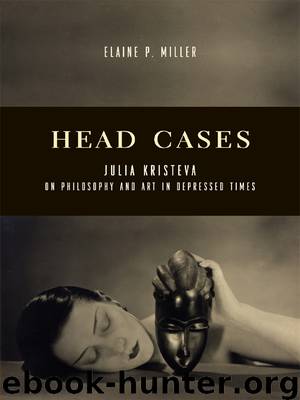Julia Kristeva on Philosophy and Art in Depressed Times by Elaine P. Miller

Author:Elaine P. Miller
Language: eng
Format: epub
Tags: PSY026000, Psychology/Movements/Psychoanalysis, PHI001000, Philosophy/Aesthetics
Publisher: Columbia University Press
Published: 2014-02-24T16:00:00+00:00
CONCLUSION: THE UNCANNY IN CONTEMPORARY ART
Photographs of the Earth from outer space no longer have a distinctly uncanny effect on us. We may, by contrast, upon viewing these photographs, have a faux (because interested) experience of the sublime as a triumphant sense of uplifting and achievement that overcomes the overwhelming distance of space travel. While the perspective from space reduces human beings to tiny insignificant specks, we nonetheless simultaneously recognize the enormous leaps humans have made in technology in order to accomplish not just visits to our moon but probes to more distant planets; satellites for the purpose of communication, entertainment, information retrieval, and weather prediction; and even space travel for those who are not expertly trained for the purpose. This in turn could lead to a feeling of the inner superiority of human beings to nature, not in scale or in power, but with reference to what Kant called our supersensible selves.163
Perhaps the correlative to Kant’s discussion of the “starry heavens” and Adorno’s description of the Earth seen from space would be the ordinary person’s perspective on the inside of his or her own body. Although the body is the very closest thing to us, most of us are not medical students, medical examiners, or coroners, and therefore we are only abstractly aware of the internal contours of the various organ systems that form our bodies. A recent exhibition, “Bodies,” gained immense controversy and a kind of popularity for affording the general public a view of dissected human body parts and fetuses and skinned corpses injected with polymers that could be cut open to expose the internal musculature and organs. The resulting exhibit is uncanny precisely by virtue of its presentation of that which is simultaneously most familiar and yet at the same time most distant. As people become more familiar with such views, the exhibit, which features mummified bodies displayed in various active positions (playing basketball, painting, or dancing), may lose some of its uncanny effect, but the ultimate inscrutability yet inevitability of death will always remain uncanny for the human being. One body in particular strikes the viewer: a female corpse smiles as she swings open the front of her torso like a door, breasts attached, to display the organs within. The uncanny effect of this particular body literally refers back to the Heim, or home, from which we all emerge. The mother’s body, in particular the womb, but also the breasts that nurture the infant, represents the mysterious origin of plenitude from which we are forever cut off but to which all of our subsequent desires in some way refer.
Kristeva points out that for Arendt, the human body is reduced to the realm of zoe, or mere life, and as such is an “uninteresting generality.”164 Such an attitude allowed her (mistakenly, of course, in Kristeva’s view) to dismiss psychoanalysis as revealing nothing more than what all humans have in common. Kristeva writes that for Arendt the body is frightening, and her reaction against it leads her
Download
This site does not store any files on its server. We only index and link to content provided by other sites. Please contact the content providers to delete copyright contents if any and email us, we'll remove relevant links or contents immediately.
| Deconstruction | Existentialism |
| Humanism | Phenomenology |
| Pragmatism | Rationalism |
| Structuralism | Transcendentalism |
| Utilitarianism |
The remains of the day by Kazuo Ishiguro(8787)
Tools of Titans by Timothy Ferriss(8184)
Giovanni's Room by James Baldwin(7161)
The Black Swan by Nassim Nicholas Taleb(6985)
Inner Engineering: A Yogi's Guide to Joy by Sadhguru(6703)
The Way of Zen by Alan W. Watts(6477)
Asking the Right Questions: A Guide to Critical Thinking by M. Neil Browne & Stuart M. Keeley(5598)
The Power of Now: A Guide to Spiritual Enlightenment by Eckhart Tolle(5582)
The Six Wives Of Henry VIII (WOMEN IN HISTORY) by Fraser Antonia(5379)
Astrophysics for People in a Hurry by Neil DeGrasse Tyson(5118)
Housekeeping by Marilynne Robinson(4301)
12 Rules for Life by Jordan B. Peterson(4235)
Double Down (Diary of a Wimpy Kid Book 11) by Jeff Kinney(4175)
The Ethical Slut by Janet W. Hardy(4160)
Skin in the Game by Nassim Nicholas Taleb(4141)
Ikigai by Héctor García & Francesc Miralles(4099)
The Art of Happiness by The Dalai Lama(4048)
Skin in the Game: Hidden Asymmetries in Daily Life by Nassim Nicholas Taleb(3905)
Walking by Henry David Thoreau(3875)
